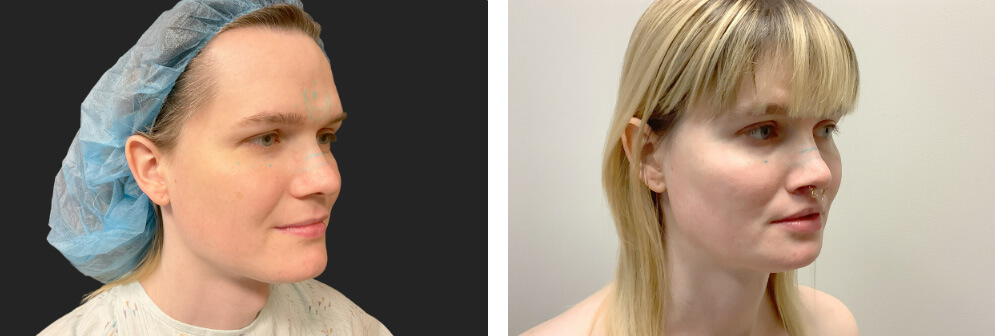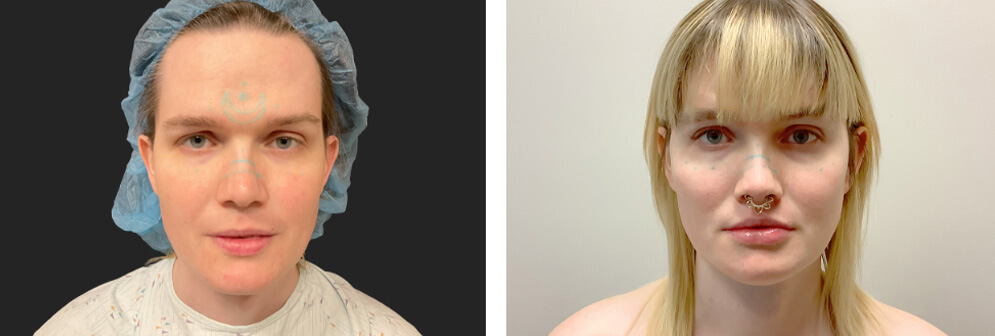Transgender Hair Restoration In Portland OR
What does Facial Feminization Surgery Involve?
Hair loss will happen to virtually everyone at some point in their lives. However, transgender women may experience male pattern baldness before deciding to transition physically. Revamping their hairline to both create a fuller head of hair and a more feminine hairline which can result in transformative results for the person’s transition and general appearance. Dr. Javad Sajan is among one of the best surgeons for MTF hair transplants and is one of only a handful of surgeons in the world who performed hair transplant surgery at the same time as facial feminization. He uses a variety of techniques including FUT hair transplant and FUE hair transplant.
Dr. Sajan offers the full range of hair transplant techniques to deliver customized, high-quality results for patients of all hair types, styles, and situations. Discover how we can support you through your transition with the best transgender hair transplant Portland, OR.
Personalized Transgender Hair Transplant In Portland
Hair loss can have many causes. While the most common cause is pattern baldness related to genetics, certain medications, medical conditions, injuries, and lifestyles can contribute to hair loss. For example, high stress, many immune system suppressing drugs, and hormonal conditions can all cause or worsen hair loss.
Because there are so many possible factors contributing to an individual’s hair loss, Dr. Sajan personalizes each transgender hair restoration to fit the patient and their needs. Frequently, the signs of pattern baldness aligning with the patient’s gender assigned at birth are present, which for transgender women may involve a receding hairline and potentially balding on the crown of the head.
MTF hormone therapy can help slow and prevent hair loss. In some cases, it may also provide a small amount of restoration. However, patients generally need a hair restoration treatment—whether surgical, non-surgical, or a combination of both—and will see the best, longest-lasting results from customized treatment.
The benefits of an MTF hair transplant with Dr. Sajan are tenfold. Patients may experience or notice benefits such as:
- A more feminine, rounded hairline
- Wispier hairline that looks more natural
- Less distance between the glabella and the hairline
- Correction of genetic hair loss
- Can use one of several different surgical techniques such as FUT hair transplant and Neograft hair restoration
- Prevention of future widespread hair loss
- No visible scarring
- Natural looking results
- Can be combined with facial feminization surgery
- Patients can undergo subsequent non-surgical procedures as maintenance
- Minimal recovery and time off work (when performed by itself)
- Surgery performed under local anesthesia
- Overall a low risk procedure
- Performed by an expert MTF hair transplant surgeon and plastic surgeon who specializes in gender affirming surgeries
Hair transplant surgery—regardless of the technique used—is usually performed while the patient is awake. Local anesthesia is applied to keep the patient comfortable. If performed with facial feminization, the patient is usually awoken from general anesthesia before undergoing hair transplant surgery. From there, Dr. Sajan will either cut a strip of skin from the back of the head (FUT hair transplant) or punch out specific follicles (FUE hair transplant and Neograft hair restoration). Once harvested, he will place the donor hair follicles precisely to create a rounder, wispy hairline. The hairline is often designed to cover any incisions from facial feminization surgery that may be present in the area.
The transplanted hair is resistant to the form of testosterone that causes hair loss. This helps prevent the transplanted hair from falling out again. Throughout the weeks and months following surgery, the new hair works to create a new blood supply to support it.
Life-Changing Results from Portland’s Top Surgeon
Transgender hair transplant for trans men is less common than for transwomen. However, sometimes FTM hormone therapy can accelerate or cause hair loss that affects the patient’s transition. In these cases, the techniques used are the same, but the placement of the new hair will differ and follow a more traditionally masculine appearance. This usually involves placing the hairline higher and creating more of a square hairline.
Transgender hair transplant for trans women frequently helps reverse pre-transition hair loss and prevent it in the future. Many transgender women see it as an important part of their transition.
Treatment Options
FUE / NeoGraft Hair Transplant
FUE and NeoGraft hair transplant use the same base method of punching out hair follicles that contain between two and four hairs on average. This reduces the risk of visible scarring and it is one of the most frequently used hair restoration methods used around the world. NeoGraft improves upon this method by using technology to identify the highest-quality follicles.
FUT Hair Transplant
The traditional form of hair transplantation—FUT hair transplant—uses a linear incision on the back of the head to harvest the donor’s hair. This does tend to yield a higher number of grafts, but it does also come with a higher risk of visible scarring. However, it can still be a viable option for many patients.
Non - Surgical
Several non-surgical hair restoration methods exist that can help create a more feminine hairline as well as maintain surgical results. This could include prescription medications like Minoxidil or injections that promote a healthy scalp environment. Dr. Sajan can discuss non-surgical options during a consultation and which may best serve you.
Before and After Hair Transplants Photos


FAQ
Who is the candidate for MTF Hair Transplant?
Many facial feminization patients are great candidates for an MTF hair transplant in Portland. Other candidates include transgender women who are otherwise satisfied with their appearance, but who are experiencing hair loss. Patients should be in generally good health and have realistic expectations for the procedure.
How much does Hair Transplant cost in Portland Oregon?
The exact cost of a hair transplant surgery will depend on the number of grafts necessary. Patients will receive a customized price quote at their consultation. Also, we do accept all private insurances and many patients have coverage for gender affirming procedures. However, we recommend contacting your insurance company to confirm and clarify coverage.
Is Transgender Hair Transplant Painful?
Patients usually remain perfectly comfortable during the procedure and feel no pain. Local anesthesia is applied before the procedure and as needed during it to ensure patients feel no pain. Some pressure may be felt, but patients often feel comfortable enough to sleep during their hair transplant surgeries.
How is the recovery post hair restoration?
Swelling, redness, and sometimes bruising can occur following hair transplant surgery. Patients should refrain from wearing anything tight fitting on their heads and showering until okayed by Dr. Sajan. Patients can usually return to work in about a week and sometimes earlier. Dr. Sajan will see patients for post-operative appointments to monitor their progress. Patients should begin to notice new hair growth at between three and six months with full results coming in after about one year.
How long will the transplanted hair transplant last?
Transplanted hair—unlike the original hair in the area—is resistant to the hormones that cause genetic hair loss. However, other causes of hair loss may still occur throughout your lifetime. Still, with good aftercare and possible non-surgical therapies, patients can expect their hair transplant to be essentially permanent.
Does Insurance Cover Transgender Hair Transplant?
Yes, insurance companies will usually cover hair transplant for transitioning patients. We recommend calling ahead to find out the specifics of your insurance plan and gender-affirming coverage.
Will I Need Multiple Gender Affirming Hair Transplants?
Potentially, some patients regardless of gender identity sometimes have more than one hair transplant. This can occur for many reasons. For example, the original treatment area could not be treated with one surgery, or more than one factor causing hair loss is present. A subsequent hair transplant may take place decades following the original one. Thankfully, any future hair transplant surgeries can usually be performed less invasively and involve fewer grafts.
Top Transgender Hair Restoration in Portland, Oregon
Dr. Javad Sajan is one of the top plastic surgeons specializing gender affirming surgery in the United States. He has trained extensively and worked closely with the transgender, nonbinary, and gender non-conforming communities to create customized, effective, and safe surgeries. Dr. Sajan provides the top hair restoration Portland, OR.
To learn more and schedule a consultation, call us at 206-990-0060. Patients can also reach out online via chat or contact form.
